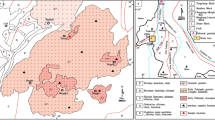Abstract
The Topsails igneous terrane of Western Newfoundland contains a diverse suite of igneous rocks, but consists mainly of Silurian alkaline to peralkaline granites and rhyolites. The terrane exhibits evidence for the coexistence of mafic and salic magmas in the form of composite dykes and flows, sinuous, boudined mafic dykes cutting granites and net vein complexes. Field data and major and trace element chemical data suggest that these magmas mixed to produce limited volumes of more or less homogeneous hydrids.
Magma mixing, a process which has received recent prominence in petrogenetic models for calc-alkaline volcanic suites, has elicited less attention than restite separation and fractional crystallization as a cause of chemical dispersion in granites. Evidence from the Topsails igneous terrane suggests the possible importance of magma mixing to granite petrogenesis and a major role for transcurrent faulting in the origin and evolution of peralkaline magmas.
Similar content being viewed by others
References
Anderson AT (1976) Magma mixing: petrological process and volcanological tool. Volcanol Geotherm Res 1:3–33
Bateman PC, Chappell BW (1979) Crystallization, fractionation, and solidification of the Tuolumne Intrusive Series, Yosemite National Park, California. Geol Soc Am Bull 90:465–482
Bowen NL (1928) The evolution of igneous rocks. Princeton University Press, pp 1–332
Cabanis B (1984) Main features of volcanism and plutonism in late Proterozoic and Dinantian times in France. In: Schenk PE (ed) Regional Trends in the Geology of the Appalachian — Caledonian — Hercynian — Mauritanide Orogen, NATO ASI Series, VolC 116:pp 187–192
Chappell BW (1978) Granitoids from the Moonbi District, New England Batholith, Eastern Australia. J Geol Soc Aust 25:267–283
Clemens JD, Wall VJ, Clarke BD (1983) Models for granitoid evolution and source compositions: restite — R.I.P. In: Lithosphere Dynamics and Evolution of Continental Crust, Geol Soc Aust Abs 9:178–179
Compston W, Chappell BW (1979) Strontium isotope evolution of granitoid source rocks. In: McElhinny MW (ed) The earth: its Origin, Structure and Evolution. Academic Press: pp 377–424
Currie KL (1984) A reconsideration of some geological relations near Saint John, New Brunswick. Geol Surv Can Pap 84-1A: 193–201
De Paulo DJ (1981) Trace element and isotopic effects of combined wall-rock assimilation and fractional crystallization. Earth Planet Sci Lett 53:189–202
Eichelberger JG (1975) Origin of andesite and dacite: evidence of mixing at Glass Mountain in California and at other circum-Pacific volcanoes. Geol Soc Am Bull 86:1381–1391
Eichelberger JC (1978) Andesitic volcanism and crustal evolution. Nature 275:21–27
Hildreth EW (1981) Gradients in silicic magma chambers: implications for lithospheric magmatism. J Geophys Res 86:10153–10192
Huppert HE, Sparks RSJ, Turner JS (1983) Laboratory investigations of viscous effects in replenished magma chambers. Earth Planet Sci Lett 65:377–381
Kouchi A, Sunagawa I (1983) Mixing basaltic and dacitic magmas by forced convection. Nature 304:527–528
McCarthy TS, Groves DI (1979) The Blue Tier Batholith, northeast Tasmania, a cumulate-like product of fractional crystallization. Contrib Mineral Petrol 71:193–209
McCarthy TS, Hasty RA (1976) Trace element distribution patterns and their relationship to the crystallization of granitic melts. Geochim Cosmochim Acta 40:1351–1358
Norman B (1974) Improved techniques for selective staining of feldspar and other minerals using Amaranth. J Res US Geol Surv 2:73–79
Norrish K, Chappell BW (1977) X-ray fluorescence spectrometry. In: Zussman J (ed) Physical Methods of Determinative Mineralogy. Academic Press, pp 201–272
Poole WH, Sanford BV, Williams H, Kelly DG (1970) Geology of southeastern Canada. In: Douglas RJW (ed) Geology and Economic Minerals of Canada. Geol Surv Can Econ Geol Rpt 1:227–304
Reading HG (1980) Characteristics and recognition of strike-slip fault systems. In: Ballance PF (ed) Sedimentation in ObliqueSlip Mobile Zones. Inter Assoc Sediment Spec Pap 4:7–26
Reid JB, Owen CE, Fates DG (1983) Magma mixing in granitic rocks of the central Sierra Nevada, California. Earth Planet Sci Lett 66:243–261
Shaw HR (1980) The fracture mechanism of magma transport from the mantle to the surface. In: Hargraves RB (ed) Physics of Magmatic Processes. Princeton University Press, pp 201–264
Spera FJ (1980) Aspects of magma transport. In: Hargraves RB (ed) Physics of Magmatic Processes. Princeton University Press, pp 265–324
Stormer JC, Nicholls J (1978) XLFRAC: a program for the interactive testing of magmatic differentiation models. Comp Geosc 4:143–159
Taylor RP, Strong DF, Kean BF (1980) The Topsails igneous complex: Silurian and Devonian peralkaline magmatism in western Newfoundland. Can J Earth Sci 17:425–439
Vernon RH, Etheridge MA, Wall VJ (1983) Magma mixing in the development of metaluminous granitoid suites of the Moruya Batholith around Tuross Head, N.S.W. In: Lithosphere Dynamics and Evolution of Continental Crust, Geol Soc Aust Abstr 9:185
Walker GPL, Skelhorn RR (1966) Some associations of acid and basic igneous rocks. Earth Sci Rev 2:93–109
Whalen JB (1983) The Ackley City Batholith, southeastern Newfoundland: evidence for crystal versus liquid-state fractionation. Geochim Cosmochim Acta 47:1443–1457
Whalen JB, Currie KL (1982) Volcanic and plutonic rocks in the Rainy Lake area, Newfoundland. Geol Surv Can Paper 82-1 A: 17–22
Whalen JB, Currie KL (1983a) The Topsails igneous terrane of western Newfoundland. Geol Surv Can Pap 83-1 A: 15–23
Whalen JB, Currie KL (1983b) The Topsails igneous terrane, western Newfoundland — 1∶100,000 map and marginal notes. Geol Surv Can Open File 923
Whalen JB, Currie KL (1984) Peralkaline granite near Hare Hill, south of Grand Lake, Newfoundland. Geol Surv Can Pap 84-1 A: 181–184
White AJR, Chappell BW (1977) Ultrametamorphism and granitoid genesis. Tectonophysics 43:7–22
Wiebe RA (1974) Coexisting intermediate and basic magmas, Ingonish, Cape Breton Island. J Geol 82:74–87
Wiebe RA (1980) Commingling of contrasted magmas in the plutonic environment: examples from the Nain Anorthositic Complex. J Geol 88:197–209
Williams H (1978) Tectonic-lithofacies map of the Appalachian orogen. Memorial University of Newfoundland, Map 1
Williams H (1979) Appalachian Orogen in Canada. Can J Earth Sci 16:792–807
Author information
Authors and Affiliations
Rights and permissions
About this article
Cite this article
Whalen, J.B., Currie, K.L. The Topsails igneous terrane, Western Newfoundland: evidence for magma mixing. Contr. Mineral. and Petrol. 87, 319–327 (1984). https://doi.org/10.1007/BF00381288
Accepted:
Issue Date:
DOI: https://doi.org/10.1007/BF00381288




